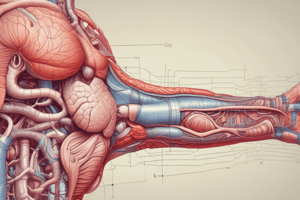Podcast
Questions and Answers
Which organ secretes hydrochloric acid and digestive enzymes to break down food?
Which organ secretes hydrochloric acid and digestive enzymes to break down food?
- Liver
- Stomach (correct)
- Small intestine
- Pancreas
Where does the initial digestion of food take place in the human digestive system?
Where does the initial digestion of food take place in the human digestive system?
- Esophagus
- Stomach
- Large intestine
- Mouth (correct)
What is the main function of the large intestine in the human digestive system?
What is the main function of the large intestine in the human digestive system?
- Forming and eliminating feces from the body (correct)
- Absorbing digested nutrients into the bloodstream
- Digesting food into nutrients
- Secretion of hydrochloric acid and digestive enzymes
Which organ system is responsible for breaking down food into nutrients?
Which organ system is responsible for breaking down food into nutrients?
What are the main nutrients in food, which need to be digested before absorption into the bloodstream?
What are the main nutrients in food, which need to be digested before absorption into the bloodstream?
What is the role of bile from the liver in the digestive process?
What is the role of bile from the liver in the digestive process?
In the human digestive system, where does the absorption of digested nutrients into the bloodstream primarily occur?
In the human digestive system, where does the absorption of digested nutrients into the bloodstream primarily occur?
Which organ in the human digestive system is responsible for secreting hydrochloric acid and digestive enzymes to break down food?
Which organ in the human digestive system is responsible for secreting hydrochloric acid and digestive enzymes to break down food?
What is the main function of bile from the liver in the human digestive process?
What is the main function of bile from the liver in the human digestive process?
Which part of the human digestive system is responsible for the initial digestion of food and salivary breakdown?
Which part of the human digestive system is responsible for the initial digestion of food and salivary breakdown?
What is the main function of the large intestine in the human digestive system?
What is the main function of the large intestine in the human digestive system?
Which organ system is responsible for breaking down food into nutrients in the human body?
Which organ system is responsible for breaking down food into nutrients in the human body?
Flashcards are hidden until you start studying
Study Notes
- A tissue is a group of cells with similar structure and function.
- An organ is a group of tissues working together for a specific function.
- The stomach is an example of an organ, containing muscle and glandular tissues.
- Organs are part of organ systems, which work together to form organisms.
- The digestive system is an organ system, responsible for breaking down food into nutrients.
- Human digestive system consists of mouth, esophagus, stomach, small intestine, large intestine, and anus.
- Food is initially chewed in the mouth and saliva begins the process of digestion.
- Stomach secretes hydrochloric acid and digestive enzymes to break down food.
- Small intestine absorbs digested nutrients into the bloodstream, with help from enzymes from liver and pancreas.
- Bile from the liver speeds up the digestion of lipids and neutralizes stomach acid.
- Feces is formed in the large intestine and eliminated from the body.
- Carbohydrates, proteins, and lipids are the main nutrients in food, which are larger than the molecules that can be absorbed into the bloodstream and need to be digested.
- Digestive enzymes break down large food molecules into smaller ones.
- Absorption of nutrients occurs in the small intestine through diffusion or active transport.
- Products of digestion, such as glucose, are used by the body for energy and building new macromolecules.
Studying That Suits You
Use AI to generate personalized quizzes and flashcards to suit your learning preferences.




